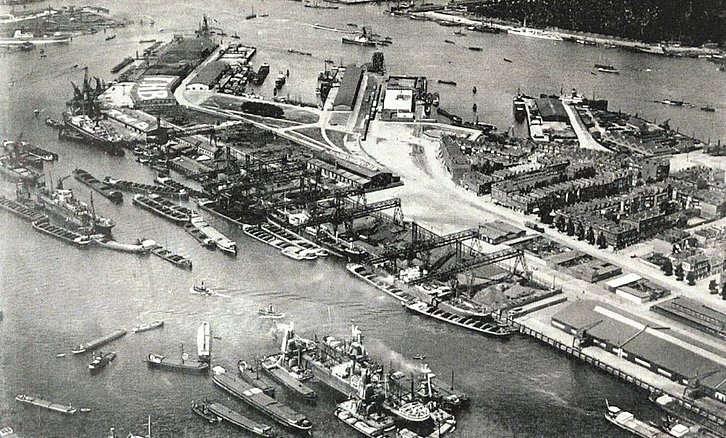It is a chilly spring day in 2019. Looking at the quiet streets of Rotterdam’s neighborhood of Katendrecht and the spruced-up buildings that line them, it is hard to imagine that a mere century ago those same streets were lined with loose women on the prowl and the buildings behind them pulsated with vice. Smoky gambling houses, cheap brothels, and musty opium dens formed the shadowy background of this unusual Dutch port. What was unusual about it? Everyone around was Chinese.
See, Katendrecht was not always the notorious working-class stronghold that Rotterdam folk knew so well. In fact, since the Middle Ages it had been a popular stopover on the road from Amsterdam to Antwerp and had thus developed as a luxury suburb. Thanks to its stunning scenery and pristine coastline, the village was also the summer getaway spot for many wealthy residents of Rotterdam, who built numerous pretty villas all around.

Then towards the end of the 19th century, local residents witnessed the worst thing that could happen to an affluent suburb – the rapidly growing port of Rotterdam was approaching. With it came the big city’s most notorious representatives in the form of sailors, stevedores, pimps, and so many other shady characters that at one point the local authorities demanded firm evidence of a person’s good standing, in order to be allowed to settle there. Rents and property prices slumped to the lowest level in the entire region. The final blow came in 1911, when the city of Rotterdam banned all brothels and in a matter of months they all moved to Katendrecht.

The 20th century began turbulently and soon the world lay in the ruins of the Great War. Lenin held Russia’s old regime by the throat and his followers appealed to the workers of the world to unite in the name of communism. As those ideas threatened to sweep through Western Europe, they emboldened laborers to demand higher wages and secure jobs, a claim that was far from appreciated by their employers. The industrial era had exacerbated more than ever the conflict between poverty of the working classes and entrepreneurial profit. Recovering enormous investments in plant and equipment required minimizing one’s labor costs and this further intensified the tension between laborers and employers. Sudden prolonged worker’s strikes were as common as their merciless suppression.
It was to neutralize one of these strikes in 1911, this time of the stokers, that the Rotterdam branch of Lloyds first brought unskilled laborers (or coolies, as they were known) from China and the Dutch colony of Java. The Chinese had none of the concerns of Dutch workers about the unbearable working conditions in boiler rooms, and the strikers were left to hang. This tactic of strike-breaking was so successful, that the following years saw a tidal wave of unskilled but cheap Chinese workers wash over the city, working both as deck hands and at the docklands. In the early 1920s, Katendrecht became Europe’s largest Chinatown.

The roots of this process began at both ends of the world. Following the Opium Wars, the European concessions in Chinese port cities like Canton, Shanghai and Nanking became major recruitment centers for coolies. Every day, young men driven to ultimate despair by decades of war, rebellions, epidemics and poverty boarded foreign ships by the thousands and did not care where they sailed off to, as long as it was away from China. These men knew nothing of strikes and labor movements. They would silently stoke the furnaces of steamships all over the world for next to nothing.

The first to benefit were the British, the dominating global power at the time. After the abolition of slavery, countless British merchant ships and their global network of ports were starving for cheap labor. Soon most maritime powers followed suit and employed numerous Chinese men. With the onset of the Great War, the British Navy blockaded the German Baltic coast and the many unemployed Chinese there easily moved to neutral Holland. Furthermore, in the aftermath of the war the global maritime business came to a halt and thousands of Chinese sailors were unceremoniously dumped in port cities around the world. Despite some 140,000 indentured Chinese laborers having served the Allied war effort, Britain and the USA tightened their immigration laws and thus redirected the flow of unemployed seamen to other destinations. The port of Rotterdam quickly became a buzzing new hot spot for Chinese migrants.

But make no mistake – Katendrecht was nothing like the early 20th century slums that housed the working class in other countries. The Dutch were known for law and order, and the docklands made no exception. The newly built neighborhood benefitted from the modern urban development principles of the time – streets were straight and perpendicular, and the residential buildings were constructed following strict guidelines for fire safety and hygiene. The police kept a keen eye on the peninsula, which was easy to close off in case a search had to be carried out. All this allowed local Chinese and Dutch families to maintain a level of respectability that was in stark contrast with the numerous brothels and gambling houses all around.
Life was strange in Chinese Katendrecht back in those early days. A growing port town was a unique place, culturally as well as demographically, as the population was mostly made up of men. In previous cases, the Dutch free market would lend a helping hand and the number of prostitutes would grow almost as fast as the number of sailors and dockland workers. This was followed by a wavering column of more or less proper brides from nearby villages, hoping to find respectable bachelors among the colorful riff-raff of the docklands.
It was not so easy for the Chinese, though, whose life was famously enclosed within the bounds of their own community. In the age-old Chinese tradition, brides had to be handpicked in their homeland and dispatched on the arduous journey all the way to Holland. The more fortunate were thus provided with Chinese wives, and the more open-minded took European wives and led the cosmopolitan life that later shaped the atmosphere of the town. As for the rest… they always had their work to keep them busy and gambling to keep them entertained.

In most ways life in Chinatown was very much like life in China. The Chinese liked to keep to themselves, both on land and out to sea. On board ships they worked, slept and ate separately from others, and even had their own Chinese cooks. On land in Katendrecht, they had their dinner in Chinese eateries, played their games in Chinese mahjong parlors, spent their money in Chinese stores, and escaped daily life in the numerous opium dens. The streets were colored by the numerous neon signs of Chinese restaurants, tea houses, cafes, gambling halls, and various other forms of entertainment. Chinese businesses grew rapidly with several families becoming successful shipping agents, employment intermediaries, chandlers and landlords. But this isolated lifestyle had little to do with discrimination. Quite the opposite, around 1935 the place with its exotic bars and restaurants became such a hit among the Dutch, that they had to organize bus tours to haul the 35,000 tourists that came every weekend from Amsterdam and the Hague.

When the shipping industry began to replace coal with oil in the 1930s, more and more Chinese lost their jobs onboard ships and settled down in the dockland community, but many were also sent back home to face the horrors of the Sino-Japanese war. At its peak, the Chinese community consisted of 1,500 permanent residents, but the total number of Chinese that came and left was anyone’s guess. The population got significantly impoverished, and one could see in the streets many desperate souls hawking peanut cookies for 5 cents apiece. They were derogatorily known as “Peanut Chinese”. More and more of these desperate workers boarded ships and never returned.

Local economy may have gone up and down between the world wars, but vice remained predictably constant. The low rents and the more relaxed legislation of the peninsula steadily drew more and more prostitution. Gambling prospered regardless of the increasing unemployment among the Chinese, and opium dens remained a problem until well after World War II. The war even boosted Katendrecht’s status as an entertainment district. In an attempt to curb the spreading of venereal diseases, German soldiers were forbidden by their superiors to visit the peninsula. Relieved of Nazi presence and strict supervision, Katendrecht flourished as a red-light district.

But in the early 1970s local residents, both Chinese and Dutch, ran out of patience. Step by step, the 120 brothels were cleared, torn down, and replaced by new residential buildings. The renovation turned Katendrecht back to a respectable neighborhood, but it also drove away much of its Chinese residents, who closed down their shops and restaurants, and relocated to the city center. The controversial charm and multi-ethnic vibe of Europe’s largest Chinatown is now only a distant memory; one that should not be forgotten.

The Shipyard

